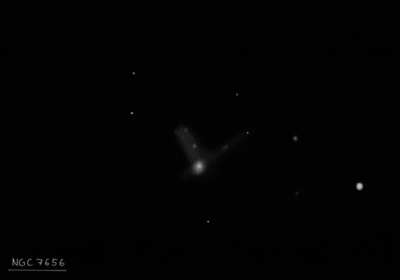
Francis Leavenworth discovered NGC 7656 = LM 1-263 on 9 Oct 1885 and recorded "vF; vS; R; bMN." There is nothing at his rough position (nearest min of RA), but approximately 1 minute of RA west is ESO 605-005 = PGC 71357. Herbert Howe measured an accurate position in 1897-98 (repeated in the IC 2 Notes). Bigourdan couldn't find this object, probably looking at the wrong position.
400/500mm - 17.5" (10/21/95): very faint, small, round, 30" diameter. Contains a very small brighter core surrounded by a very faint halo. This is an unusual, distorted interacting system with loops and filaments, though no structure was seen.
600/800mm - 24" (9/30/16): at 282x; fairly faint, fairly small, slightly elongated, 20" diameter, contains a small slightly brighter nucleus. ESO 605-004, 13' WNW, appeared very faint, fairly small, roundish, 20" diameter, low even surface brightness. ESO 605-006, 14' NE, was only occasionally glimpsed as an extremely faint glow, small, ~15" diameter, possibly elongated. The trio is catalogued as KTS 72 (Karachentsev Triplets, South).
24" (8/23/14): fairly faint, fairly small, round, 20"-24" diameter, weak concentration. The loop structure to the northeast was not noticed. ESO 605-004 lies 13' WNW.
900/1200mm - 48" (11/1/13): at 488x and 610x appeared fairly faint to moderately bright, round, ~24" diameter, high surface brightness. Surprisingly, a low surface brightness wing or loop extending to the northeast was immediately noticed. This loop is brighter along the northern edge and passes through a mag 16.7 star (or stellar galaxy), increasing the overall length to 45" extending southwest (core) to northeast (loop). A mag 16.5 star lies 1.3' W and another mag 16.5 star is 1.4' N. 2MASX J23242536-1902139, an extremely compact galaxy (V = 15.7) lies 1.9' NW. Finally, 2MASX J23243030-1903019, an extremely faint quasi-stellar galaxy was glimpsed less than 30" NNW, although another loop in that direction was not seen.
Notes by Steve Gottlieb